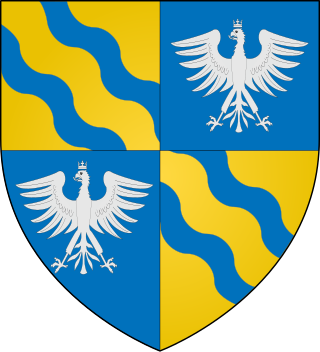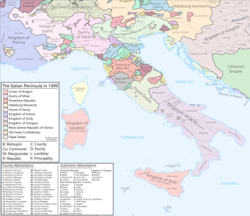
The House of Savoy was a royal dynasty that was established in 1003 in the historical Savoy region. Through gradual expansion, the family grew in power from ruling a small Alpine county north-west of Italy to absolute rule of the Kingdom of Sicily from 1713 to 1720, when they were handed the island of Sardinia, over which they would exercise direct rule from then onward.

Saluzzo is a town and former principality in the province of Cuneo, in the Piedmont region, Italy.

The Duchy of Massa and Principality of Carrara was a small state that controlled the towns of Massa and Carrara from 1473 until 1829.

The Duchy of Mantua was a duchy in Lombardy, northern Italy. Its first duke was Federico II Gonzaga, member of the House of Gonzaga that ruled Mantua since 1328. The following year, the Duchy also acquired the March of Montferrat, thanks to the marriage between Gonzaga and Margaret Paleologa, Marchioness of Montferrat.

The House of Caetani, or Gaetani, is the name of an Italian noble family, originally from the city of Gaeta, connected by some to the lineage of the lords of the Duchy of Gaeta, as well as to the patrician Gaetani of the Republic of Pisa. It played an important role in Rome, in the Papal States and in the Kingdom of Naples, and later in the Kingdom of the Two Sicilies.

Ceva, the ancient Ceba, is a small Italian town in the province of Cuneo, region of Piedmont, 49 kilometres (30 mi) east of Cuneo. It lies on the right bank of the Tanaro on a wedge of land between that river and the Cevetta stream.

Manfred IV was the fifth marquess of Saluzzo from 1296, the son of Thomas I and Luisa of Ceva.

The Marquisate of Saluzzo was a historical Italian state that included parts of the current region of Piedmont and of the French Alps. The Marquisate was much older than the Renaissance lordships, being a legacy of the feudalism of the High Middle Ages.

William VIII Palaiologos was the Marquis of Montferrat from 1464 until his death.
William VII, called the Great Marquis, was the twelfth Marquis of Montferrat from 1253 to his death. He was also the titular King of Thessalonica.
William VI was the tenth Marquis of Montferrat from 1203 and titular King of Thessalonica from 1207.

The Aleramici were a northern Italian noble and royal dynasty of Frankish origin which ruled various northwestern Italian territories in Piedmont and Liguria from the 10th to the 14th century, also reigning over the Kingdom of Jerusalem and the Kingdom of Thessalonica during the 12th and 13th centuries. Their name derived from count Aleramo, proclaimed first Marquis of Central Liguria by emperor Otto the Great in 966. The Aleramici were divided in two main lines: the Marquises of Savona or del Vasto, and the Marquises of Monferrato. In the 14th century the line of Monferrato ended in Irene of Montferrat, Empress of Constantinople, whilst the line of Savona carried on in multiple descending branches.
John Jacob Palaeologus was the Margrave of Montferrat from 1418 to 1445.

The Marquisate of Incisa was a lordship of the House of Aleramici in southern Piedmont, northern Italy, which existed between the 12th and 16th centuries.

The Marquisate of Finale was an Italian state in what is now Liguria, part of the former medieval Aleramici March. It was ruled for some six centuries by the Aleramici branch known as marquesses del Vasto and later Del Carretto, when Savona became a free commune. In 1598 the Marquisate was sold by its last marquis, Sforza Andrea to Philip II of Spain and in 1713 it was finally ceded to the Republic of Genoa, where it remained so until 1797, when it was invaded by Napoleon, ceasing its existence.

The monarchy of Italy was the system of government in which a hereditary constitutional monarch was the sovereign of the Kingdom of Italy from 1861 to 1946.

The House of Malaspina was a noble Italian family of Longobard origin that descended from Boniface I, through the Obertenghi line, that ruled Lunigiana from the 13th to the 14th centuries, and the marquisate of Massa and lordship of Carrara since the 14th century.

The Ceva Grimaldi are an Italian noble family established in Southern Italy since the 16th century but whose origins are in Piedmont and Liguria and date back to the 10th century. The main titles associated with this branch of the Ceva family are Marchese di Pietracatella and Duca di Telese.

















